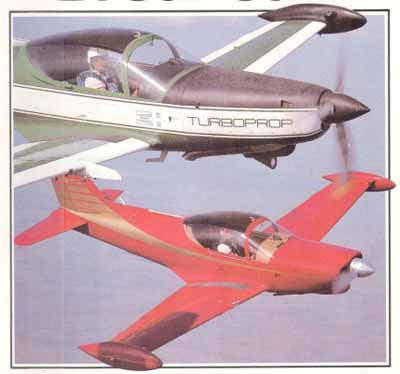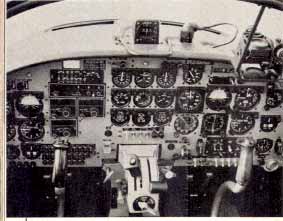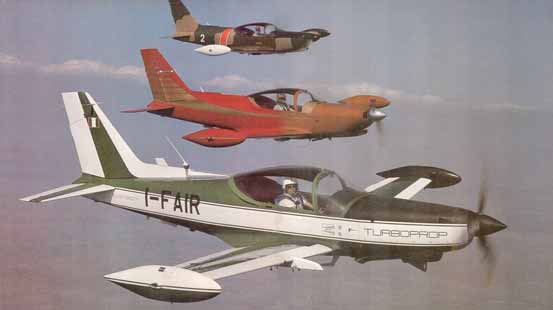PAGE FIVE
 |
The Allison 250 is a fraction
the size of a Lycoming and makes the 260TP look pretty snarky. |
THE ITALIAN SCREAMER --the Turboprop S.F. 260TP
Certainly those who own SF.260s stay awake at night dreaming ways
of pumping more horses into their planes. That's simply a trait of
the types of individuals who own such an airplane. When they see the
Siai-Marchetti SF.260 TP demonstrator running around the country, they
must go into a frenzy figuring ways of absconding with an Allison 250
turboprop and bolting the unit to the front of their airplane. That's
all it takes to make a great airplane nearly unbelievable.
The SF.260 TP is a direct response to a Third World need for a trainer
that expands the training envelope from primary training right up
to jet transition. Also, there's a problem of procuring avgas in
some of these countries where they are already operating turbo-prop
or jet aircraft on standard Jet A.
THE SF.260 TP OFFERS SOME OBVIOUS ADVANTAGES as a trainer. First of
all, in a primary trainer, side-by-side seating has always proven itself
superior to tandem seating, because the student is not isolated
from his/her instructor in an entirely new environment. The TP also
allows the instructor to keep a closer eye on the student and monitor
any problems in developing proficiency. With the turbine installed,
the aircraft now has enough performance that the curriculum can be
extended to include many of those missions performed by the smaller
jet aircraft such as T-37s and Fouga Magisters.
The concept of the turbine trainer has certainly caught on, since virtually
every manufacturer has a similar project being offered to the same
country, including Beechcraft's T-34C. Besides the side-by-side
seating, one advantage of the SF.260 TP has over everyone of the other
trainers is that it costs a third to a half as much and still delivers
the same training capabilities.
Another real advantage of the turboprop is that the additional horsepower
allows the 260 to hoist some pretty impressive ordnance loads off the
ground if you have an urge to go chase natives through the jungle.
The Allison 250 has 430 shaft horsepower but is derated to 350 on the
SF.260 TP. The TP is equipped with a propeller capable of not only
full feather and ground idle modes, but also has a reversed Beta position.
I am not certain what advantage this is in a military environment,
but Mike Moore delighted in backing the airplane into its parking spot
at River Ranch.
 |
Like all military 260's the
TP is right command. Notice the gunsight mounted in the right
pilot position. |
Starting the engine is deceptively simple . . . so deceptive that the
first time around I missed part of what was going on. This occurs because
the starting switch is hidden in the top of the condition lever and
not only starts the turbine spinning, but automatically sequences a
number of actions which means the pilot does nothing but sit and watch.
Once running, with the condition lever forward, all the pilot has to
worry about is the power lever which is actually controlling the pitch
of the propeller. With the prop in the ground idle mode, the airplane
tends to taxi a little on the fast side and you find yourself cycling
out of the detent now and then to nibble at zero pitch or grab a little
reverse pitch to slow it down.
I had expected the TP to fly like a bomb but I wasn't totally prepared
for the first takeoff. We sat on the centerline and I brought the power
lever up to give me 800 degrees on the tailpipe and scanned the gauges
to see that everything was stabilized. I brought the levers up and
released the brakes at the same time and suddenly found the airplane
doing its best to go honking off towards the left side of the runway
like a Mustang. A little healthy right rudder kept the situation straight
and I started to pick the nose up as the airspeed raced through 60
knots. As soon as the nosegear is off so is the airplane. We were up
and climbing at something in the neighborhood of 2,000 feet a minute
while I tried to get my wits about me and bring the gear up. We had
topped a cloud deck at 7,500 feet while I was still trying to figure
out where all the gauges were.
At 11,500 feet we were trucking along at 165 to 175 knots indicated,
which trued out that particular day to something in the neighborhood
of 200 knots, which Moore says is pretty much typical. The hand-book
shows a cruise speed of 206 knots, which in my estimation is a little
on the high side, although this particular airplane was the factory
prototype, a reengined C model.
Sixty-five TPs have been purchased by six countries and they all have
a slightly different instrument layout, a shorter throttle and other
refinements aimed at doing a little better job of mating the turbine
to the airframe.
The 260 TP flies almost identically to the 260 C with the exception
that it goes like stink. One area that is quite a bit different is
the stall. Because of the residual thrust of the prop, the TP does
not want to drop its nose as quickly in a stall as the C does. Moore
had mentioned this to me when we were doing a stall series, but it
wasn't until later when I flew the 260 C that I saw there was a definite
difference in the reluctance to fall through the stall. Landings are
virtually identical although that residual thrust does tend to want
to keep the airplane up a little bit longer, actually making it easier
to get a smooth touchdown than with a C. The neat thing is when you
hit the runway you can bring the prop back into the Beta position and
come to a screeching halt in nothing flat.
The SF.260 TP is not slated to be released on the civilian market
because, among other things, it has no civilian certification and the
price tag is pretty healthy. Even so, the Marchetti maniacs in this
country all have given thoughts to acquiring an Allison 250 Stateside
and shipping the engine overseas to have their airplane converted.
Whether or not Marchetti will want to play that game is an unanswered
question, but it is certainly the stuff of which dreams are made.
GO TO NEXT PAGE
|

